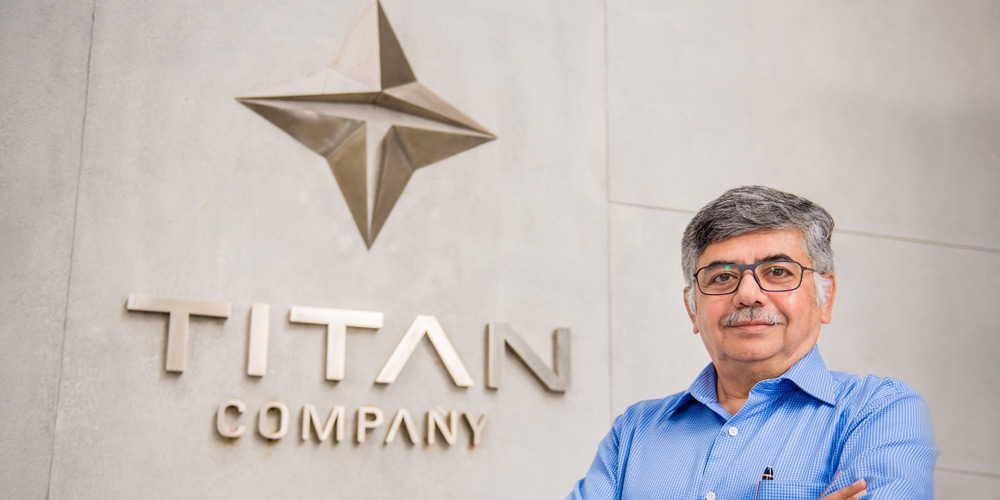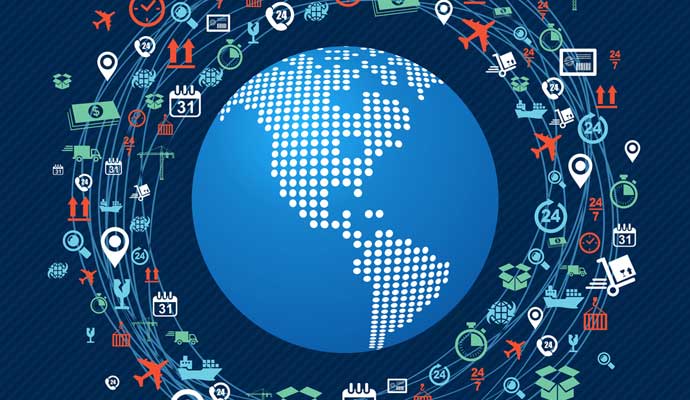Innovating in traditional retail markets
How Bhaskar Bhat turned an Indian watchmaking startup into a lifestyle giant.
This interview is part of the Inside the Mind of the CxO series, which explores a wide range of critical decisions faced by chief executives around the world.
The story of Titan, the fifth-largest watch manufacturer in the world, is the story of serendipity. In a quest for an exciting project, two employees of the Indian conglomerate Tata Group decided to design a watch, even though the Indian government closely regulated business and banned large corporations from manufacturing watches at the time. Bhaskar Bhat was their first recruit in 1983; the first Titan watch hit the market four years later.
In his 35-year career at the company — during which he was managing director from 2002 to September 2019 — Bhat built Titan into a multibillion-dollar retail powerhouse that today sells jewelry, eyewear, precision engineering components (through a separate subsidiary), and, most recently, handwoven saris, in addition to watches. It has a base of 100 million customers, and in 2018, sales topped Rs197 billion (US$2.75 billion). Titan’s market value under Bhat’s leadership has increased from Rs 2.22 billion (US$30 million) in 2002 to its current value of Rs1.03 trillion (US$14.3 billion).
Bhat’s biggest legacy, however, is his continued emphasis on family culture, both inside the company and with customers. Titan’s advertising has always revolved around relationships and rites of passage: birthdays, graduations, weddings, retirement. This focus on people is underscored by the social causes the company promotes, such as the education of girls, artisan skill centers, and a women’s empowerment initiative.
Bhat sat down with strategy+business just before his retirement from the company in September 2019 to discuss the underlying principles and decisions that took Titan from a scrappy startup to a consumer retail powerhouse.
S+B: You are regarded as the leading architect of Titan’s journey into the digital age. What are your thoughts on that transformation?
BHAT: We’ve just begun the journey. We are leaders in our categories and invested in digital systems and platforms three years ago. But it’s a long journey from where we are to where we want to be. Our customers are not all entirely digital, and in India, digital is minuscule. Even those businesses which were born digital are now investing in brick-and-mortar stores. We’ve seen this with one of our acquisitions aimed at online expertise, CaratLane, where the growth in physical stores has outpaced the online store. This wasn’t because of any actions on our end, but due to our customers’ desire to touch and feel the products.
S+B: What does “going digital” mean for a company like Titan?
BHAT: For us, the digitization of the company is both external and internal. The former is the consumers’ interface with the company — websites, online promotions, social networks like Instagram and Facebook — while the latter is the transactions with the company, the way people make actual purchases. The jury is still out on that because, for us, the physical space still plays a large role. We are, therefore, betting on omnichannel as the safest approach, and that is playing out pretty well in eyewear, and to some extent, watches.
S+B: How do you learn about what your customers want?
BHAT: Though not our largest investment, the most important investment we’ve made in the last few years is in analytics and customer relationship management. Our integrated loyalty program, Encircle, has a base of around 12 million users in all our categories. By engaging with our customers digitally, we’ve been able to understand behavior and effectively translate that into more than 1,000 targeted promotions. This is one significant source of information about where our customers are going to shop. Another source involves marketplaces like Amazon and Flipkart, which provide us with feedback on how our consumers are behaving online.
S+B: What is the company’s largest investment?
BHAT: If we take automation as the first step toward digitization, then we started with automating the supply chain or ERP. I think people don’t give that enough credit, but that is where it all began: from manual planning systems to automating the whole supply chain. Those are the biggest investments. It was first in watches, then in jewelry and eyewear. Those investments have become table stakes. Much later, we invested in the front end by automating the point of sale, and we integrated that with the back end, which includes the real-time data. In jewelry, for example, the supply chain has to be real time due to the high cost of working capital.
S+B: So, if prices change, you don’t want to be holding expensive inventory?
BHAT: That’s one part of it. The other is that the lead time for manufacturers is very short. We have a pull-based replenishment supply chain [using analytics to estimate when items will run out] for a large percentage of the jewelry sales. The cost was significant, but the system lets you calculate return on investment because you can calculate the production and lead time, reduction in time-to-market, reduction in inventories, customer satisfaction, etc. We started this 22 years ago on the operations side. Digitization at the front end is getting celebrated today because the world values anything to do with marketing, but we transitioned all the businesses from forecasting to replenishment in 1997. That was a fundamental change, and it happened because forecasting, although a science, was never a perfect system. The best we could ever do was forecasting for the so-called evergreen products. For new products there is no equation that could tell you how much you will sell, so there you need a forecasting unit.
S+B: Why is the pull-replenishment model particularly successful for jewelry?
BHAT: Jewelry is a low-margin business in India, and it works on a daily pricing model; today’s price in the store would be different from yesterday’s price. This means you have to keep the entire supply chain very lean. We buy yesterday what we expect to sell today.
The complexity in this is that we have some 300 stores. Each store, theoretically, represents a catchment area for customers, but the nature of the demand in each catchment varies. In India, the taste in jewelry is different not just from state to state, but also from area to area within cities. The South Bangalore taste is vastly different from West Bangalore taste. The proportion of diamond jewelry in the West Mumbai store is 48 percent, while the national average is 25 percent. We therefore have to stock each store with what that catchment area needs, and that is what the merchandising team deals with.
I was at a store yesterday asking the merchandising team how they go about it. Though database management is a part of it, the teams also sit in the stores and talk to customers and the in-store salespeople. They garner information on fast-selling products — what is not selling and why. They have targets on stock turns, and on sell-throughs, among other things. This is human intervention, but finally there is so much data produced that you need automation to manage it all. We were one of the first to work with [Eliyahu M.] Goldratt’s Theory of Constraints lean manufacturing model. After executing it in watches, we now do it in eyewear. We have benefited a great deal from this.
S+B: When you started out in watches, you emphasized research and quickly letting go of things that didn’t work. How do these two approaches work today, especially given the amount of data collected?
BHAT: They’ve helped in sharply focusing our day-to-day management on what to produce and what not to produce. For example, in the early days, we entered the clock business and then, based on economic considerations, we exited after a few years. Today we are relaunching clocks, but they are exclusively wall clocks. That has come about by listening to consumers at our stores and in the Encircle database. You have to be able to listen to weak signals and work them into an opportunity. There’s a risk as to whether the business proposition will end up being good enough, but because we are launching wall clocks online to test the waters, the cost is low. The same goes for smart watches, which are primarily introduced online at first.
S+B: As CEO, how did you introduce new strategies, such as digitization, into the different businesses?
BHAT: We have four divisions — watches, jewelry, eyewear, and a new division that includes a sari business called Taneira. The way we manage the company is to have expertise in each of these businesses, but we also have a top team that engages on subjects of strategic importance to the company. That was my agenda, things like leadership development, digitization, internationalization of the company. These are all on the division CEOs’ tables, but we all work together on them.
The decisions start at the top, and then the division carries them forward with oversight from me. For example, the acquisition of CaratLane was primarily driven by me and the CFO when we realized the need for an online play in jewelry. The digital team reported to me, while the online marketing of products is housed within the division.
S+B: How did you get into the sari business?
BHAT: That emerged from a separate initiative from within. This company has always been very exploratory from inception. Our entry into jewelry after watches represented a bet we took on India and the Indian lifestyle. We’ve used many methods to determine where we should be going. In the very beginning, the process was top-down. In the last 15 years, it has been a collective approach. The last time we engaged in this process, it resulted in the sari business being born.
You have to be able to listen to weak signals and work them into an opportunity.”
We decided to create a startup initiative within Titan. We launched a program called Ignitor, where we encouraged teams to come up with ideas for the future. And we published what we called Titan’s Hexagon: There are six elements that ought to be considered for selecting a business to pursue. It must be an unorganized, not regulated category; it must be a personal product; the category must be amenable to branding; design should be an important element in the purchase consideration; cost should not be an important driver; and the category should not be intensively competitive. We will never enter the mobile phone business, for example.
When we launched the Ignitor program, we had 700 entries. We went through a jury process, and out of a final short list of 14, three are seeing the light of day. One of them is Taneira, the sari business, and the other two are furniture and silver. We’ve now entered a new phase, and we will be focusing on wearables and separating accessories from watches.
S+B: The entry into wearables changes the playing field because the competition is not just other watch companies.
BHAT: Years ago, we realized a watch is not just a timekeeping device. It became a gift, and then we moved on to thinking about it as an accessory. Now, with the smart watch, it is a functional accessory. We don’t see wearables being limited to the watch alone. It can be glasses, jewelry, and more. The possibilities are immense, but to be honest, it is beyond our pay grade, and we have to hire people who can get us there. What we know is that we have to get there. Devices that gain value by connecting to other devices can be a big game changer, especially if all these devices and the data in them can be accessed and integrated. It’s a very, very alluring idea.
S+B: Titan is known for tapping into emotions, in its relationships with its employees and dealers and also in the way it tells the company story. Given the increasing shift to digital, how do you continue with that narrative?
BHAT: It has become easier. Our campaign Dua ka Sona (The gold you buy is blessed) is a testament to that. With digital, we are able to reach millions of people with this idea. And we’re not doing it to create demand alone. We are also trying to change people’s perceptions about jewelry. This might lead them to ask questions about how the jewelry was made, how we worked with the karigar (artisan) who made the jewelry in our store, and how we are looking after the community.
S+B: How does artificial intelligence fit into this model?
BHAT: Titan is looking at artificial intelligence in two ways. One is on the operations side in how it can improve things for us, which is simply getting better at pulling data from the entire environment and crunching it. The second way pertains to consumers, and how we can make their life better, instead of focusing on how we can do more business with them. With the former approach, I believe we will end up with more business, and with the latter we’ll better understand our customers. As of now, Titan is in very early stages of applying artificial intelligence.
S+B: What does it mean to be a leader in a time of such quick digital transformation?
BHAT: It’s not easy. You feel inadequate every day. The thing I think people like Mr. [Ratan] Tata [emeritus chair of Titan’s parent, Tata Group] do so well is they go to the core: the customer. What will all this change do for your consumer? That’s where experience and wisdom are indispensable. I don’t want to hear the technology talk; I want to hear about the benefits that it can deliver, or how it can transform society.
We have not gone to hiring an expert to run the business. We have a “Titanian” to head the business who understands the benefit of our consumer-centricity and developing relationships. All our leaders have come from within and they’ve been around for a long time. This way, we have inbuilt DNA of a certain kind. We hire externally only when we need specific expertise. Our digital head has come from the outside. The person who was CFO for many years was hired externally. However, even in those cases, we ensure that they are “Titanized.”
S+B: What do you see as Titan’s most important accomplishment?
BHAT: We have journeyed over the last 35 years not just to create a business or a corporation, but to build an institution. For us, business is about creating a sense of ownership in the company. For me, the difference between a corporation and an institution is simple: It is the spring in your step on Monday morning to come to work. While there is a lot we can still do, many of our people say that we are family, and I’m happy to have contributed in some way to that.





